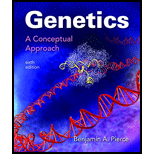
a.
To explain:
The type of chromosome mutations required to change the chromosome
Introduction:
Chromosomal rearrangements are the mutations in chromosomes that alter the structures of individual chromosomes. The four types of chromosomal rearrangements are deletions, duplications, translocations, and inversions.
a.
Explanation of Solution
Duplication is a type of mutation, which results in the duplication or doubling of some part of the chromosome. For the conversion of
b.
To explain:
The type of chromosome mutations required to change the chromosome
Introduction:
Chromosomal rearrangements are the mutations in chromosomes that alter the structures of individual chromosomes. The four types of chromosomal rearrangements are deletions, duplications, translocations, and inversions.
b.
Explanation of Solution
Duplication is a type of mutation which results in duplication or doubling of some part of the chromosome. For the conversion of
c.
To explain:
The type of chromosome mutations required to change the chromosome
Introduction:
Chromosomal rearrangements are the mutations in chromosomes that alter the structures of individual chromosomes. The four types of chromosomal rearrangements are deletions, duplications, translocations, and inversions.
c.
Explanation of Solution
Inversion is a type of chromosomal rearrangement mutation which involves inversion of a segment of chromosome to
d.
To explain:
The type of chromosome mutations required to change the chromosome
Introduction:
Chromosomal rearrangements are the mutations in chromosomes that alter the structures of individual chromosomes. The four types of chromosomal rearrangements are deletions, duplications, translocations, and inversions.
d.
Explanation of Solution
In deletion mutation, some part of the chromosome gets deleted which results in shortening of chromosome. For the conversion of
e.
To explain:
The type of chromosome mutations required to change the chromosome
Introduction:
Chromosomal rearrangements are the mutations in chromosomes that alter the structures of individual chromosomes. The four types of chromosomal rearrangements are deletions, duplications, translocations, and inversions.
e.
Explanation of Solution
In deletion mutation, some part of the chromosome gets deleted which results in shortening of chromosome. For the conversion of
f.
To explain:
The type of chromosome mutations required to change the chromosome
Introduction:
Chromosomal rearrangements are the mutations in chromosomes that alter the structures of individual chromosomes. The four types of chromosomal rearrangements are deletions, duplications, translocations, and inversions.
f.
Explanation of Solution
The inversion mutation involves inversion of a segment of chromosome to
g.
To explain:
The type of chromosome mutations required to change the chromosome
Introduction:
Chromosomal rearrangements are the mutations in chromosomes that alter the structures of individual chromosomes. The four types of chromosomal rearrangements are deletions, duplications, translocations, and inversions.
g.
Explanation of Solution
The inversion mutation involves inversion of a segment of chromosome to
h.
To explain:
The type of chromosome mutations required to change the chromosome
Introduction:
Chromosomal rearrangements are the mutations in chromosomes that alter the structures of individual chromosomes. The four types of chromosomal rearrangements are deletions, duplications, translocations, and inversions.
h.
Explanation of Solution
For the conversion of
i.
To explain:
The type of chromosome mutations required to change the chromosome
Introduction:
Chromosomal rearrangements are the mutations in chromosomes that alter the structures of individual chromosomes. The four types of chromosomal rearrangements are deletions, duplications, translocations, and inversions.
i.
Explanation of Solution
For the conversion of
Chromosomal rearrangements include deletion, inversion, duplication, and translocation. For the conversion of segment of chromosome into another, one or more than one type of chromosomal rearrangement takes place.
Want to see more full solutions like this?
Chapter 8 Solutions
Genetics: A Conceptual Approach
 Human Anatomy & Physiology (11th Edition)BiologyISBN:9780134580999Author:Elaine N. Marieb, Katja N. HoehnPublisher:PEARSON
Human Anatomy & Physiology (11th Edition)BiologyISBN:9780134580999Author:Elaine N. Marieb, Katja N. HoehnPublisher:PEARSON Biology 2eBiologyISBN:9781947172517Author:Matthew Douglas, Jung Choi, Mary Ann ClarkPublisher:OpenStax
Biology 2eBiologyISBN:9781947172517Author:Matthew Douglas, Jung Choi, Mary Ann ClarkPublisher:OpenStax Anatomy & PhysiologyBiologyISBN:9781259398629Author:McKinley, Michael P., O'loughlin, Valerie Dean, Bidle, Theresa StouterPublisher:Mcgraw Hill Education,
Anatomy & PhysiologyBiologyISBN:9781259398629Author:McKinley, Michael P., O'loughlin, Valerie Dean, Bidle, Theresa StouterPublisher:Mcgraw Hill Education, Molecular Biology of the Cell (Sixth Edition)BiologyISBN:9780815344322Author:Bruce Alberts, Alexander D. Johnson, Julian Lewis, David Morgan, Martin Raff, Keith Roberts, Peter WalterPublisher:W. W. Norton & Company
Molecular Biology of the Cell (Sixth Edition)BiologyISBN:9780815344322Author:Bruce Alberts, Alexander D. Johnson, Julian Lewis, David Morgan, Martin Raff, Keith Roberts, Peter WalterPublisher:W. W. Norton & Company Laboratory Manual For Human Anatomy & PhysiologyBiologyISBN:9781260159363Author:Martin, Terry R., Prentice-craver, CynthiaPublisher:McGraw-Hill Publishing Co.
Laboratory Manual For Human Anatomy & PhysiologyBiologyISBN:9781260159363Author:Martin, Terry R., Prentice-craver, CynthiaPublisher:McGraw-Hill Publishing Co. Inquiry Into Life (16th Edition)BiologyISBN:9781260231700Author:Sylvia S. Mader, Michael WindelspechtPublisher:McGraw Hill Education
Inquiry Into Life (16th Edition)BiologyISBN:9781260231700Author:Sylvia S. Mader, Michael WindelspechtPublisher:McGraw Hill Education





